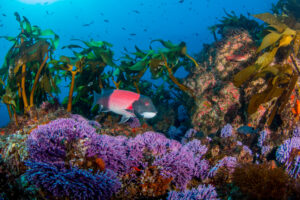California Seeks Feedback on Draft Strategy to Achieve 30×30 Conservation Target
To protect biodiversity, advance equitable access to nature, and combat climate change, the California Natural Resources Agency today released a groundbreaking document detailing strategies and opportunities to conserve 30 percent of California’s lands and coastal waters by 2030.
The draft of Pathways to 30×30: Accelerating Conservation of California’s Nature is now available for public review and feedback. Pathways to 30×30 responds directly to Governor Gavin Newsom’s Executive Order N-82-20, which aims to accelerate conservation of California’s lands and coastal waters through voluntary, collaborative action, and makes California the first state to commit to the ambitious global “30×30” target.

Photo by Zack Gold
“The level of collaboration and leadership by OPC on 30×30 has been tremendous. I look forward implementing this strategy together,” says Dr. Jennifer Norris, Deputy Secretary for Biodiversity and Habitat and lead for 30×30 California.
OPC has coordinated closely with Dr. Norris and additional CNRA leadership on the coastal and ocean components of California’s 30×30 initiative, building on the Conservation of Coastal Waters Advisory panel report released earlier this year. The pathway to conserving 30 percent of California’s coastal waters by 2030 will include the 16 percent of state waters currently protected within the state’s network of marine protected areas and a prioritized focus on working with federal resource managers to strengthen biodiversity conservation measures in California’s federally managed National Marine Sanctuaries, which currently cover 40.6 percent of state waters.
Sanctuaries provide an opportunity for California to meet or exceed the 30×30 target while ensuring that access and sustainable use is maintained. Strengthened protections within Sanctuaries could include:
- Restoring and revitalizing indigenous stewardship,
- Phasing out the use of particularly harmful fishing gear,
- Strengthening water quality protections,
- Restoring degraded habitats,
- And/or banning single-use plastics within Sanctuary watersheds.
Moving forward, OPC will be working with the research community, other state and federal agencies, Tribes and Tribal governments, and coastal stakeholders – including commercial and recreational fishermen – to identify areas that are important for biodiversity in California’s coastal waters, assess major threats to biodiversity and explore additional protections that could be implemented to address those threats.
“OPC is looking forward to working with the National Marine Sanctuaries, fishing and environmental communities, and other ocean stakeholders to develop and implement a path to 30 percent conserved coastal waters by 2030”, said Dr. Mark Gold, Deputy Secretary for Oceans and Coastal Policy and Director of the Ocean Protection Council. “We have an extraordinary opportunity to leverage our efforts with the federal 30×30 initiative with an objective of thriving coastal waters.”
Do you have thoughts on how California can best protect biodiversity and achieve “30×30” for the coast and ocean? We want to hear from you! Visit CaliforniaNature.ca.gov to review the draft Pathways to 30×30 document and submit feedback by February 15, 2022.

